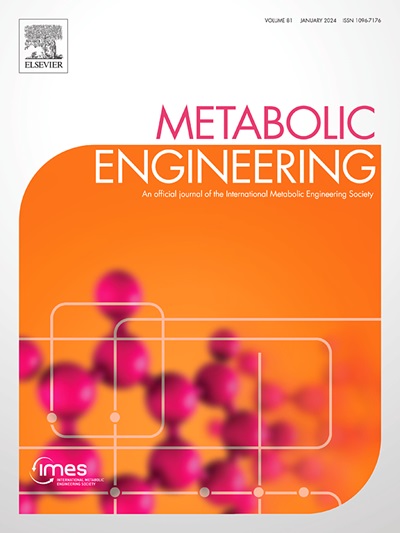The faucet knob effect of DptE crotonylation on the initial flow of daptomycin biosynthesis
IF 6.8
1区 生物学
Q1 BIOTECHNOLOGY & APPLIED MICROBIOLOGY
引用次数: 0
Abstract
We propose here that acylation modification of actinomycete proteins is a restrictive system that limits the excessive synthesis of secondary metabolites, its mechanism has not been clearly elucidated before. We used crotonylation as an example to investigate the acylation effect in the daptomycin biosynthesis by Streptomyces roseosporus. Our experiments revealed abundant crotonylation of numerous secondary metabolic enzymes in Streptomyces roseosporus, a daptomycin producer. DptE, which initiates daptomycin biosynthesis, is crotonylated at K454. We experimentally identified the corresponding DptE crotonyltransferase Kct1 and decrotonylase CobB. Further studies consistently confirmed that decrotonylation increases DptE activity. Decrotonylation functions like loosening a faucet knob, increasing substrate channel throughput and the initial flow of daptomycin biosynthesis. Moreover, DptE catalytic activity was enhanced via K454 and neighboring residues K184 and Q420 mutation, increasing daptomycin yield by 132%; daptomycin biosynthesis related metabolism activities also increased. Substrate channel prediction revealed 38% higher throughput for mutant DptE (K454I/K184Q/Q420N) than crotonylated DptE. Molecular dynamics (MD) simulations revealed significant increases in flexibility and substrate affinity of the mutant. In summary, we elucidated the faucet knob effect of DptE crotonylation on the initial flow of daptomycin biosynthesis and adopted decrotonylation to generate high-yield industrial strains.
DptE 巴豆酰化对达托霉素生物合成初始流程的龙头旋钮效应。
我们在此提出,放线菌蛋白质的酰化修饰是一种限制次生代谢产物过度合成的约束系统,但其机制尚未得到明确阐明。我们以巴豆酰化为例,研究了玫瑰孢链霉菌在达托霉素生物合成过程中的酰化效应。我们的实验发现,作为达托霉素生产者的玫瑰孢链霉菌(Streptomyces roseosporus)中的许多次级代谢酶都存在大量的巴豆酰化作用。启动达托霉素生物合成的 DptE 在 K454 处被巴豆酰化。我们通过实验确定了相应的 DptE 巴豆酰基转移酶 Kct1 和脱巴豆酰基酶 CobB。进一步的研究一致证实,脱质子酰化增加了 DptE 的活性。脱质子酰化的作用就像松开水龙头旋钮,增加了底物通道的吞吐量和达托霉素生物合成的初始流量。此外,通过 K454 及其邻近残基 K184 和 Q420 的突变,DptE 的催化活性得到了增强,使达托霉素的产量增加了 132%;达托霉素生物合成相关的代谢活动也有所增加。底物通道预测显示,突变 DptE(K454I/K184Q/Q420N)的吞吐量比巴豆化 DptE 高 38%。分子动力学(MD)模拟显示,突变体的灵活性和底物亲和力显著提高。总之,我们阐明了 DptE 巴豆酰化对达托霉素生物合成初始流程的龙头旋钮效应,并通过去巴豆酰化生成了高产工业菌株。
本文章由计算机程序翻译,如有差异,请以英文原文为准。
求助全文
约1分钟内获得全文
求助全文
来源期刊

Metabolic engineering
工程技术-生物工程与应用微生物
CiteScore
15.60
自引率
6.00%
发文量
140
审稿时长
44 days
期刊介绍:
Metabolic Engineering (MBE) is a journal that focuses on publishing original research papers on the directed modulation of metabolic pathways for metabolite overproduction or the enhancement of cellular properties. It welcomes papers that describe the engineering of native pathways and the synthesis of heterologous pathways to convert microorganisms into microbial cell factories. The journal covers experimental, computational, and modeling approaches for understanding metabolic pathways and manipulating them through genetic, media, or environmental means. Effective exploration of metabolic pathways necessitates the use of molecular biology and biochemistry methods, as well as engineering techniques for modeling and data analysis. MBE serves as a platform for interdisciplinary research in fields such as biochemistry, molecular biology, applied microbiology, cellular physiology, cellular nutrition in health and disease, and biochemical engineering. The journal publishes various types of papers, including original research papers and review papers. It is indexed and abstracted in databases such as Scopus, Embase, EMBiology, Current Contents - Life Sciences and Clinical Medicine, Science Citation Index, PubMed/Medline, CAS and Biotechnology Citation Index.
 求助内容:
求助内容: 应助结果提醒方式:
应助结果提醒方式:


